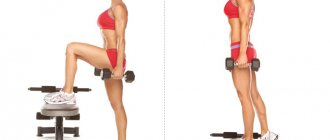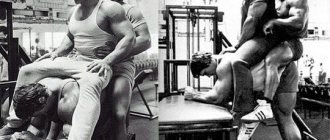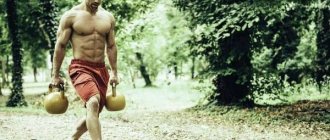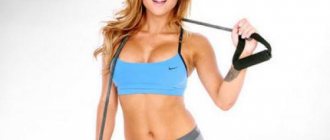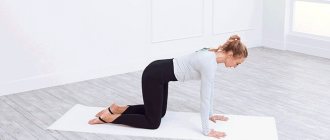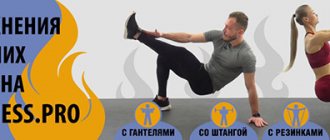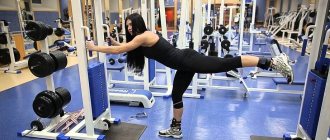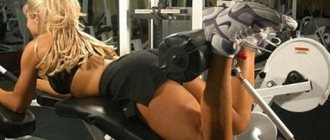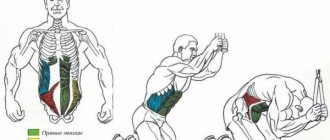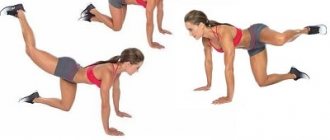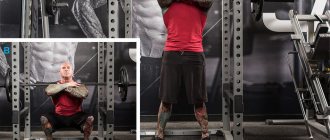Good morning exercise which muscles work
Back and Abdominal Workout
Louis Simmons
In the squat and deadlift, the success of the movement depends on keeping your back in the correct position. This requires a strong back as well as strong abdominal muscles.
At Westside, we do our best effort work on the same day, Monday. The same muscles work in these movements. Accordingly, combining special exercises that benefit both movements saves energy.
Let's first look at the spinal erectors and how to develop them. Good mornings are performed approximately 40% of the total training time. This means 4 to 10 Mondays. There are different options for good mornings. Work for a maximum of 3 repetitions.
With bending and bent legs (Bent over with legs bent)
Bent over with legs straight
This exercise will develop the spinal erectors and improve the elasticity of the hamstrings.
With an arched back and straight legs (Arched back with legs straight)
This type of good morning will develop static strength in the spinal erectors, which will be great for keeping your back arched during squats or sumo deadlifts. Lower the bar as far as you can see without losing the arch in your back.
Power version of good mornings with an arched back (Power arched good mornings)
Use a very wide stance, a low bar position, and lean, rather than bend, forward until the bar is in front of your knees. Very heavy weights can be used. This is not a quarter squat. Remember, the bar should be in front of your knees after bending forward.
Combined good morning with squat (Combo squat/good morning)
Note
This exercise is very important to stretch all the muscles involved in the squat and deadlift. Using a medium stance width and a low bar position on your back, bend forward until your back is close to parallel with the floor.
Then roll your lower back back and lower yourself into a full squat position. To stand up, straighten your legs. This exercise is very effective for building great extension strength as well as creating tightness in the movement.
You will feel your eyes popping out of your head when you are at the bottom of the movement.
Seated good mornings on a box
Sit on a parallel or higher box and bend over. This method of execution excludes the legs from the exercise, which is very useful if you are injured or have a large belly.
Seated good mornings on a bench
Sit on the bench so that it is between your legs and bend until your face touches the bench. This exercise is suitable for lifters with a narrow waist and good flexibility.
These combinations are known as the contrast method. Warning: The use of rubber bands can lead to severe muscle pain due to the heavy load in the eccentric phase due to the tension of the bands, causing a delayed onset of muscle soreness (DOMS) effect.
This phenomenon occurs with any type of eccentric stress, but it is especially pronounced with elastic bands.
Back raises or hyperextensions
These exercises are performed on a special machine where your feet are fixed and your torso is supported while you lie face down. Lower your upper body until your head is close to the floor. Then rise to parallel, but not higher, to prevent hyperextension of the back.
Reps should be 3-8, go for a new maximum as soon as you can. The 1968 Olympic champion Voldemar Bazanovsky could do 4 repetitions with 225 (approx. trans.
– it’s not clear what – if in pounds, then it’s not enough, it’s all about, even I can do so much, maybe of course I’m doing it wrong), so – let’s get to work!
Pull-throughs with straight legs
Pull the cable from the pulley machine with the lower pulley passed between your legs while standing with your back to the machine. If you do this exercise with your legs straight, this exercise will target your lower back. Do it for a large number of repetitions, in some cases to failure. Performed with bent legs, this exercise will target the glutes.
Reverse hyperextensions
The most important
The Reverse Hyper workout is miles ahead of any other back exercise - from the middle to the bottom. It not only works the entire lower back, but also rotates the sacrum.
Also, during each repetition, when the weight is placed under your face, it opens the intervertebral discs and allows cerebrospinal fluid to enter this space, thus providing recovery in addition to increasing strength.
Abdominal muscles
In my opinion, side bends are the most important abdominal exercise.
The obliques not only work as stabilizers, but are also responsible for straightening the legs at the bottom of a deadlift or the bottom of a squat.
You need to learn to squeeze your abdominal muscles outward, expanding them despite the resistance of the belt. Dumbbell side bends for a while - bend to the side and return to a straight position.
Side deadlifts
Lateral rows also work the abs and obliques. Stand in front of the bar, facing the plates on the right or left side. Raise the barbell, being careful not to bend to the side. This exercise will work the obliques and stability in your glutes.
We prefer to do side bends using an overhead block. Stand in front of the lat machine, grab a block with a triceps strap near your neck, and lean away from the machine into a side bend.
There is some stress on the back in this exercise.
Standing situps with lat machine
Take a triceps strap, hold it at the back of your neck, with the two ends of the strap facing your chest, and stand facing away from the machine.
Helpful advice
Now, bend forward as far as possible, pushing your abs outward. Most lifters are quite weak when they first try this exercise, but you need to be patient.
The weight will go up and so will your deadlift and squat.
Leg raises
Leg raises of any type are a good exercise. Start with a lying position and bent leg raises. Then move on to straight leg raises. If your shoulders are in good condition, perform hanging leg raises.
Do them with your legs bent at first until you are strong enough to do them with your legs straight. Use weight if you can.
Read more: Plank exercise for abs and weight loss. How to do Plank correctly?
The hardest type of leg raise is lifting your legs to the bar you are hanging from.
Please don't be fooled by bodybuilding magazines. Your hip flexors/extensors and abs should work together. Bent-legged sit-ups are useless unless you have a very weak back and abs.
There are so many back exercises to choose from. Only a small part is shown here. Some of the exercises will work better for some people than others. And that's why you need to have a good selection from which to choose.
The information in our series of articles is the result of experiments on 43 elite powerlifters that we trained over many years. We have a system that will teach you how to teach yourself.
In this article we will look at such an unusual exercise.
like “good morning” slopes.
When performing this exercise, the lower back, back of the thigh, and gluteal muscles are actively involved in the work.
This exercise works the gluteal muscles well and will also help diversify your leg and butt training program.
Like any basic exercise, “good morning” requires a good warm-up and warm-up of all major muscle groups.
Technique:
- Feet are shoulder width apart
- We hold the barbell with a wide grip, place it on the trapezium and straighten up;
- The body should be straight, the back slightly arched in the lower back, the chest and shoulders straightened, the lower back muscles tense, and the legs slightly bent at the knees.
- We take a deep breath and, holding our breath, smoothly lean forward, simultaneously moving our pelvis back
- At the moment when the body becomes parallel to the floor, we return to the starting position
- Raising your torso, simultaneously pull your pelvis forward
- We exhale only when we overcome the most difficult part of the climb.
- It is necessary to slightly bend your knees in the starting position. This will increase stability. It also minimizes the likelihood of injury.
- During the entire exercise, you must firmly hold a slight bend in the lower back.
- Note that the torso tilts due to flexion of the hip joint, not the lumbar spine.
- Raising the torso from a bend is carried out only due to the efforts of the buttocks and hamstrings. Don't try to lift your torso by straightening your lower back, or round your back by leaning forward.
- Master bending only with an empty bar and at a slow pace. Add weight only when you feel that your lower back has become stronger.
How effective is the so-called “Good morning” exercise for the buttocks?
“Good morning” is a complex exercise that uses several muscle groups at the same time in various ways. It helps strengthen the muscles of the legs, back and buttocks. However, it is often ignored due to fear of back injury.
The exercise got its name because it looks like a bow. This is why many people don’t like him - from the outside it seems that something just went wrong during the squat. Some people are intimidated by the technology itself.
Yes, of course, if done carelessly you can get seriously injured. However, in order to overcome a plateau in strength training, the “Good Morning” exercise is ideal.
First of all, the muscles of the back of the thigh are involved during the exercise. They work together with the hamstrings to provide knee mobility. Hamstring strength is important for many sports and in everyday life.
Also active are the so-called synergist muscles, which act in conjunction with others. These include the gluteal muscles and the adductor magnus muscle. The glutes are responsible for stretching, rotating, and lateral movement of the hips. The adductor magnus is a small muscle that is also involved in all movements of the hips.
The “Good Morning” is an exercise that also engages the small but very important erector spinal muscles, which not only promotes a strong back, but also healthy posture and proper gait.
As with any other physical activity, despite all the benefits and active work of various muscle groups, there are always risks.
The “Good Morning” is an exercise that is great for working the hamstrings and back, but if done incorrectly, it is also the most dangerous of all.
The risk of injury is greatest when the body is closest to parallel to the floor. In this case, the weight of the bar puts maximum pressure on the spine. If the technique is incorrect and the back muscles are not strong enough, this is a direct path to sick leave.
Note
If you are a beginner, then do not rush to do the good morning exercise, first train on squats and Romanian deadlifts.
You should also remember that this is one hundred percent not an exercise where you should experiment with extremely heavy weights. In this case, it's all about technique, and if you want to show off strength, there are plenty of other back-friendly options.
The exercise seems quite simple to perform, but nevertheless it is important to remember a few simple rules:
The “Good Morning” exercise with a barbell is very similar in technique to squats:
- The beginning is similar to squats. Stand straight with your feet shoulder-width apart. Place the barbell on your shoulders, take a deep breath and tighten your abdominal muscles.
- Begin to push your hips back, slightly bending your knees. Continue to push your hips back, lowering your torso until it is almost parallel to the floor. At the bottom, your shins should remain perpendicular to the floor and your knees should be slightly bent.
- Slowly bring your hips forward and lift your body. So you said “Good morning” to the gym.
The exercise is quite simple to perform, but it is better at first, if you are practicing on your own, to film the technique on video so that you can analyze the errors.
Variations
If you find it difficult or impossible to perform an exercise with a barbell, there are several variations:
- With elastic band. This option minimizes the load on the spine and allows you to effectively work the buttocks and hamstrings.
- With dumbbells. Take one dumbbell of suitable weight and hold it under your chest. This is a good option for practicing technique before moving on to the barbell.
- Isometric "Good morning". Slowly lower yourself to almost parallel with the floor, then hold this position for 2-10 seconds and return to the starting position. Isometric exercises are the best way to build strength quickly.
- "Good morning" on one leg. This more advanced version of the exercise is performed on one leg. Allows you to increase strength and train your sense of balance. But be extremely careful.
The exercise can also be performed with any other weights: chains, barbell plates, and so on.
Read more: Barbell row to the chin: technique, mistakes, video
Conclusion
“Good morning” is an exercise that effectively targets the gluteal muscles, hamstrings and lower back. However, extreme caution should be used when performing it, as failure to follow the technique can result in serious injury.
If you are unable to perform any variation of the exercise, you can still provide sufficient load on the target muscles with squats, deadlifts and deadlifts.
- Exercise quot;Good morningquot; quite difficult to perform, without the correct body position this exercise is very dangerous and ineffective. So it’s better to replace it with Hyperextensions:
quot;Good morningquot; — isolates part of the back muscles, but in its dynamics it is similar to the Straight Leg Row.
The basic exercise for the muscles of the legs and buttocks is Squats. There are many options for performing this exercise. To form a good shape of the buttocks, working with weights, it is important to do 20 or more repetitions per approach, and without weights from 100 to 200. Everything depends on the physical preparation of the trainee.
Weighted squats combine well with hyperextensions and lunges. Multiple repetitions of squats can be combined well with moving your legs back and to the side. Well, these combinations can be perfectly combined with different types of jumps and runs.
I did this exercise, they advise 15-20 repetitions, 4-5 approaches. I completed 2 approaches, and I must say, I don’t feel any strain in my buttocks, rather general fatigue. Perhaps it’s just me, I prefer this exercise for my buttocks. Here, after the first minute, you feel that your buttocks are working.
But if you perform it incorrectly, you risk killing your lower back, so when performing this exercise, it is advisable to first become familiar with the technique and then do it.
And of course, take adequate weight, otherwise you will not be able to perform any correct technique.
Contraindications
Despite all the benefits, bending over with a barbell on your shoulders has a reputation as a traumatic exercise. However, this is the difference between almost all exercises performed with weights. If we highlight the main causes of injuries during strength training, there are only two of them:
- Too much weight, not suitable for the athlete.
- Violation of technology.
Improperly performing bends with a barbell on your shoulders does create a risk of injury. The lumbar spine may be affected first.
To minimize the risks during training, an athlete needs to honestly assess his physical fitness before performing an exercise.
- If you have problems with your back (in particular, with the lower back), it is better to refrain from bending over with a barbell on your shoulders. Any chronic pain in the lumbar region will only get worse under stress.
- In terms of difficulty, barbell bending is a fairly advanced workout that requires an understanding of body mechanics and muscle control. Therefore, start with light weights and gradually increase the load.
- Another important contraindication is a weak core. The exercise does not pump up the torso, but strong core muscles are necessary to keep the back straight.
Despite the name “good morning”, it is not recommended to perform the exercise during your morning workout. After sleep, our hydrophilic intervertebral cartilage fills with water. They are like liquid balloons ready to burst. The discs support your body weight and gradually compress throughout the day. But if you immediately load them with a barbell, the pressure may be excessive and there is a risk of injury. Therefore, perform the “good morning” exercise at least 2-3 hours after sleep, because your health is in your hands.
Forward bends with a barbell, or the “GOOD MORNING” exercise
≡ December 21, 2020 Category: Exercises by muscle group
For some advanced athletes who go to the gym, the training program involves performing specific exercises. Some of these movements acquire second names after long practice.
These include the exercise known among experienced athletes as “Good morning”. Unlike the second name, this exercise is not very popular among those who want to quickly gain weight and pump up, but its benefits for the body are considerable.
Therefore, in today’s article we will pay attention to precisely this type of action, which in the world of sports is called – bending forward with a barbell on the shoulders.
The main factor that played a role in the formation of the second name - Good morning, was the principle of reproducing movements during bending forward with a barbell. Similar to bowing when greeting, they are very valuable in training the lower back, buttocks, hamstrings, and indirectly the abs.
An ordinary exercise with an unusual name, Good Morning, uses a decent group of muscles. Basically, it is designed to work the muscle tissue of the posterior chain.
In addition, the atlas of muscles involved in the exercise includes the following.
Basic:
- lower and middle back, as well as spinal extensors;
- hamstring muscles (biceps, semimembranosus, semitendinosus);
- large gluteals.
Additional muscles are the external oblique and rectus abdominis muscles.
The full picture of the muscle atlas is presented in the photo, and the execution technique is shown in the video.
Despite its simple name, good morning, this exercise is unique from the point of view of performing movements. To achieve greater efficiency, it is necessary to correctly perform all stages of physical actions, starting with taking the starting position and observing proper breathing, which ensures increased efficiency of the “good morning” exercise.
Before you begin physically greeting and performing good morning, you need to take the starting position: standing, feet shoulder-width apart.
From this position, bend forward to grab the barbell with a wide grip with your palms facing you, and place it, straightened, on your trapezium. In this case, the body should be straight, the chest should be directed forward, and the shoulders should be straightened.
Keep your lumbar muscles tight to get the desired effect from your good morning sports greetings.
Helpful advice
The movements should begin with slightly bent knees. Smoothly bending forward with a barbell on your shoulders, you need to simultaneously move your pelvis back, continuing the action until the moment when the body becomes parallel to the floor. After bending, also smoothly return to the starting position.
It is important to pay attention when performing the exercise with the interesting name Good Morning, the basis of the movements is a change in the position of the hip joint. That is, the forward tilt of the body occurs due to flexion of the pelvis (which can be seen in the video below), and not according to the principle of classical bending, in which flexion is carried out in the lumbar region.
Breathing technique is also important when performing good morning bends. Having taken the starting position with the barbell on your shoulders, inhale while bending. You can exhale when returning to the starting position.
The execution technique will be ideal as all the nuances of the Good Morning exercise are mastered. In addition, having mastered some experience in the classic implementation of the Good Morning exercise, you can try its other variations:
- bending forward with a barbell on your shoulders from a sitting position on a bench;
- bending forward while standing with one leg extended in front of oneself;
- standing forward bends when using a Smith machine;
- Good morning at home with body bending over the table.
In order for the exercise with the simple name Good Morning (or Good Morning) to stimulate the work of the above muscle groups (hips, buttocks, back and abs), you should follow the recommendations:
- when performing movements, the gaze should always be directed forward, as can be seen in the video;
- since the effectiveness of Good morning does not lie in gaining weight, but in strengthening the back and increasing muscle strength, it is not recommended to use heavy weights;
- It is recommended to do Good Morning in combination with deadlifts, 2-3 sets each of 8-10 repetitions.
Forward bends with a barbell, or the “GOOD MORNING” exercise, is a technique aimed at strengthening the muscular corset of the back (in particular the muscles of the lower part). The exercise also allows you to train your buttocks, giving them a rounded and sculpted shape. In addition, the back of the thigh is well worked out and stretched.
It is recommended to perform forward bends with a barbell along with deadlifts, presses and lunges.
Read more: Plie squat with dumbbells: technique, what muscles work
Muscles at work
When performing the “GOOD MORNING” exercise, the following muscle groups are involved in the work:
- The main ones are the muscles of the lower back and spinal extensors, buttocks, and the back of the thigh.
- Additional group - the middle part of the back, rectus abdominis and oblique muscles.
The main equipment is a bar.
For beginners, it is recommended to use a bodybar first, gradually adding weights to it. And only after that can you use a heavy projectile.
Execution technique
At first glance, you may think that the GOOD MORNING exercise has a simple technique. This is not entirely true. Even a slight deviation from the correct technique can lead to pain and injury to the lower back.
Starting position:
- Place your feet shoulder-width apart, bend your knees slightly and arch your back;
- Take the barbell with a wide grip and fix it on the back of the shoulder girdle;
- Make sure your back is stiff and your shoulder blades are joined together;
- Bend smoothly forward while moving your pelvis back;
- When fixing your torso parallel to the floor, return to the starting position.
As you inhale, lower your body down, and as you exhale, return to the starting position.
Be careful! You lean forward with the barbell by working the hip joint and in no case the lower back.
There are several variations of the “GOOD MORNING” exercise:
- while sitting on a sports bench;
- with emphasis on the leg put out in front of you;
- performing the technique on one leg.
Possible mistakes
The main mistakes when performing the technique are:
- bending due to extension of the lower back. That's right - by using the force of the hip joints (buttocks and biceps);
- complete relaxation of the spinal extensor muscles. That's right - this muscle group should not be completely relaxed, otherwise the tension moves to the lower back;
Recommendations
- When bending forward with a barbell, do not lower your head down, but look in front of you all the time;
- do not use too much weight on the projectile, since the main emphasis is on the back muscles;
- When performing the technique, make sure that your knees are slightly bent, this increases stability and protects against injury.
It is impossible to safely lift heavy weights without strong posterior chain muscles.
Considering the load that falls on the back, gluteal muscles and biceps of the thighs when practicing CrossFit, you need to use all possible methods of strengthening these muscles - deadlifts, Romanian deadlifts, rows, hyperextensions, etc. But this time we will shed light on forward bends with a barbell, called “good morning” in the West (translated as “good morning”).
Bent-overs with a barbell, as mentioned above, load the muscles of the posterior chain, namely:
- erector spinae muscle
- hamstrings
- gluteal muscles
- upper back muscles
- blade stabilizer
- rectus and oblique abdominal muscles
Execution technique
- Stand up to your full height, take the barbell and place it on your back - as when doing squats (the bar is located on the rear deltoids);
- Turn your toes slightly away from each other and bend your knees slightly (the angle at the knees should remain the same throughout the entire execution);
- Move your pelvis as far back as possible and tilt your body forward until it is parallel to the floor. Remember to keep your spine in a neutral position. The main limiting factor when performing a bend may be the flexibility of the hamstrings;
- As soon as your body reaches parallel to the floor, begin to return it to a vertical position, while simultaneously pulling your pelvis forward.
Barbell curls can be performed while seated to isolate the back muscles and reduce stress on the hamstrings. Other options for “good mornings” include bending over with a dumbbell, on one leg, with a rubber loop, or Zercher’s “good mornings.”
Benefits of Execution
Strengthening the lower back. Barbell squats, deadlifts, and weightlifting movements require strong lower back muscles. Increasing isometric stress on the erector spinae and engaging the glutes and hamstrings can help avoid injury and improve performance.
Development of the buttocks and hamstring muscles. For this reason, “good mornings” can often be found in training programs for powerlifters and weightlifters. The goal of performing barbell bends is not only muscle hypertrophy, but also to develop the correct motor patterns, which can later be transferred to competitive movements.
Upper back strength. The ability of muscles to prevent spinal flexion is what reduces the risk of injury when performing deadlifts and squats.
Integrating barbell curls into your training plan depends on your workout goals. As a general rule, perform 3-4 sets of 8-12 repetitions to hypertrophy and develop strength in the lower back and hips. It is not recommended to use a heavy weight apparatus in this exercise.
Bent-overs can also be used as a warm-up with several sets of 8-10 barbell reps at 30X0 tempo.
20 June 2009
Good morning is not only a good morning wish in the language of the Celts and their descendants, but also an affectionate name for an excellent exercise that builds strength, shapes and increases the attractiveness of the muscles of the lower back, buttocks and hamstrings.
If you include this movement in your training program, then quite quickly you can feel how your buttocks are filled with berries, your legs are tightened at the back, and an attractive “butterfly” appears in the lumbar region.
Correct technique: how to do it correctly
Good morning is not recommended for beginners
, as it requires developed core muscles to keep the back straight. In addition, bending over with a barbell requires careful adherence to technique. It is well suited for athletes with average and high levels of training.
Today's interest in strength training with weights has brought renewed attention to auxiliary exercises before strength training. Such auxiliary exercises include the “Good Morning” exercise with a barbell on the shoulders, which was quite popular in Soviet times.
Is the “Good morning” exercise with a barbell safe?
In the 70s, “Good Morning” turned out to be undeservedly forgotten due to the fact that it was included in the list of traumatic ones. However, the modern technique of performing squats, where the emphasis is placed primarily on hip movement rather than on knee extension, has given rise to a second life for the exercise. Today in powerlifting, the barbell good morning is considered the premier utility exercise. To maximize the involvement of the thigh muscles, professional powerlifters perform the “good morning” with a wide stance, but if you do not want to additionally load the thigh muscles, use a “shoulder-width apart” stance. Also, to reduce the risk of injury, beginners today are encouraged to do “good morning” exercises with a barbell in a power rack.
Another important point: the barbell should not be placed on the shoulders itself, but on the trapezius. The key to safety will be the correct technique for performing the “Good Morning” exercise.
What muscles are used when doing the good morning exercise?
When bending the torso with a barbell on the shoulders is performed, first of all, the load goes to the lower back: the extensor muscles of the spine. It is for this reason that you should refrain from exercising if you have problems with your spine.
In addition to the lower back muscles, the gluteus maximus and hamstring muscles are worked.
If you are not sure, give preference to a lighter load. To warm up, do a few reps with an empty bar or minimal weight.
How to do the Good Morning exercise with a barbell on your shoulders
- Set the barbell at shoulder level.
- Place the bar on the back of your shoulders in the same way as you do. The back is arched in the lower back, the knees are slightly bent, the shoulder blades are together. For greater stretching of the gluteal muscles, you can perform the exercise with straight legs.
- For the starting position, take a step back from the stance. Place your feet shoulder-width apart, head up.
- Inhale and move your pelvis back, bending at the waist (see photo). Perform this movement until the upper part of the body is located almost parallel to the floor. Make sure that throughout the exercise your back remains arched and your spine straight. If this seems too difficult, then you should reduce the working weight.
- As you exhale, straighten up and return to the starting position.
- Perform the required number of repetitions of the exercise.
Bent-overs with a barbell on the shoulders are used by athletes to strengthen the muscles of the lower and middle back, as well as additionally work out the buttocks and back of the thighs. The movement itself resembles a greeting with a bow, hence the second name of the exercise - “good morning”. Including this exercise in your training program will improve your posture, gain back strength necessary to perform many basic exercises, and improve the shape of your buttocks, visually separating them from your hips.
For women, this exercise can also be useful because it does not load the quadriceps, allowing you to work the muscles of the “back” group.
